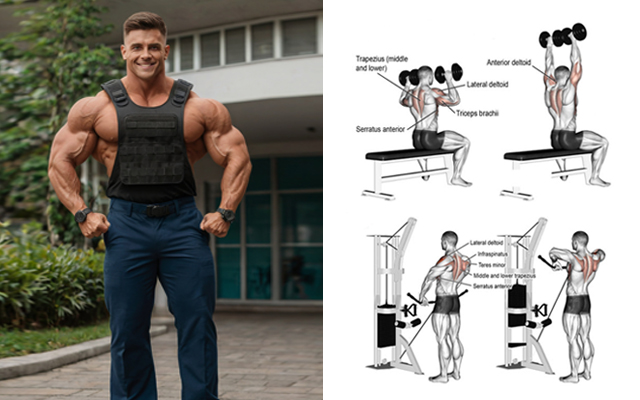Your shoulders are amazing joints, offering a wide range of motion for everyday activities and athletic pursuits. But this flexibility comes at a cost – they can be prone to injury if not kept strong and stable. That's where shoulder exercises come in! Here's why they're important:
Why You Should Be Doing Shoulder Exercises: Strength, Stability, and More!
Reduced Injury Risk:
Strong shoulder muscles, especially the rotator cuff which stabilizes the joint, can significantly decrease your chances of getting hurt. This is crucial for activities like throwing, swimming, or weightlifting.
Improved Posture:
Strong shoulders help pull your back muscles down and keep your core engaged, leading to better posture. This not only looks good but also reduces back pain and improves overall balance.
Greater Strength and Power:
Stronger shoulders translate to more power in pushing and pulling movements. This can benefit your workouts, sports performance, and even daily tasks like carrying groceries.
Increased Range of Motion:
Regular shoulder exercises can help maintain and even improve your shoulder's mobility. This allows for greater freedom of movement and reduces stiffness that can come with age.
Better Overall Fitness:
Shoulder exercises don't operate in isolation. They often work alongside other muscle groups, leading to a more well-rounded physique and improved overall fitness.
Exercises for Everyone:
Whether you hit the gym or prefer bodyweight exercises at home, there are shoulder exercises suitable for all fitness levels.
Remember: Proper form is key to maximize benefits and avoid injury. Consider consulting a trainer or physical therapist to learn proper technique for different exercises.
By incorporating shoulder exercises into your routine, you're investing in the health and functionality of these crucial joints. So, get those shoulders moving and reap the rewards of a stronger, more stable upper body!
Top 5 Exercises For 3D Delts
1- Shoulder Press
Adjust the bench to an upright position 90
degrees if you're using one. Sit down on the bench and plant your feet firmly
on the floor, shoulder-width apart. Grab the dumbbells and start with them
resting on your thighs.
Raise the dumbbells one at a time to shoulder
level, palms facing forward. Keep your elbows bent at a 90-degree angle and
core engaged throughout the exercise.
Breathe out and press the dumbbells directly
overhead until your arms are almost straight. Imagine pushing the ceiling with
the dumbbells. Don't completely lock your elbows at the top.
Inhale and slowly lower the dumbbells back down
to shoulder level in a controlled motion. Maintain good form throughout the
movement.
2- Arnold Press
Sit on a weight bench with your back upright
and core engaged. Hold the dumbbells in each hand at shoulder level with your
palms facing your body thumbs pointing inwards.
As you press the dumbbells overhead, slowly
rotate your wrists so your palms end up facing forward at the top of the
movement. Imagine you're screwing the dumbbells into the ceiling.
Maintain control throughout the movement. Don't
swing the dumbbells to get them overhead. Breathe out as you press the weights
up.
Aim for full extension at the top, with your arms
straight but not locked. Squeeze your shoulder blades together at the peak of
the movement.
Slowly lower the dumbbells back down to
shoulder level, rotating your palms back to the starting position as you go.
Breathe in as you lower the weights.
3- Front & Side Raises
Stand tall with a dumbbell in each hand at your
sides. Palms can face your thighs or be neutral.
Keep your knees slightly bent and core engaged
throughout the movement.
Raise the dumbbells out to the sides until they
reach shoulder height Lateral Raise.
Lower the dumbbells back down to your sides
momentarily.
Without pausing, lift the dumbbells directly in
front of you, towards your shoulders Front Raise.
Lower the dumbbells back down to your sides to
complete one rep.
4- Bent Over Flys
Find a bench or sturdy chair with a backrest.
Adjust the height so your knees are bent at a 90-degree angle when you sit down.
Pick up dumbbells with a neutral grip palms
facing each other and sit on the bench. Lean forward from your hips, keeping your
back relatively straight but with a slight hinge at the waist. Your torso
should be angled forward at roughly 30 degrees. Maintain a neutral spine
throughout the exercise.
Let the dumbbells hang straight down from your
shoulders, arms extended down towards the floor. This is your starting position.
Breathe in and squeeze your rear deltoids to
lift the dumbbells up and out to the sides, keeping your elbows slightly bent.
Imagine you're trying to pinch your shoulder blades together. Don't lift the
dumbbells too high; bring them up until your arms are roughly parallel to the
floor.
Focus on using your rear delts to lift the
weights, not your lower back or biceps. Keep your core engaged throughout the
movement.
Breathe out as you slowly lower the dumbbells
back down to the starting position. Don't let the weights swing freely; control
the descent.
5- Cable Upright Rows
Adjust the cable pulley to the lowest setting.
You can use a straight bar, EZ bar, or rope attachment.
Grab the attachment with a pronated grip palms
facing down. Stagger your hand position slightly, with one hand a bit higher
than the other.
Stand tall with your feet shoulder-width apart, core engaged, and shoulders back and down.












0 Comments